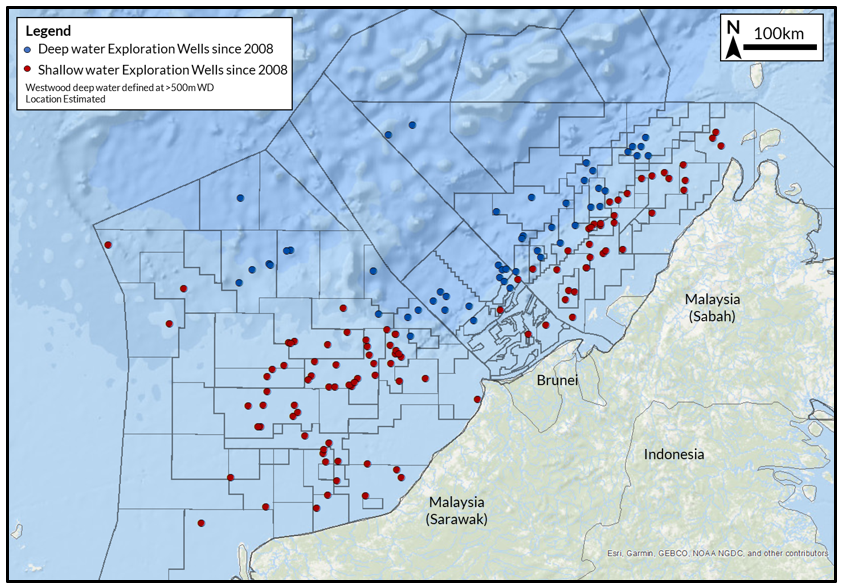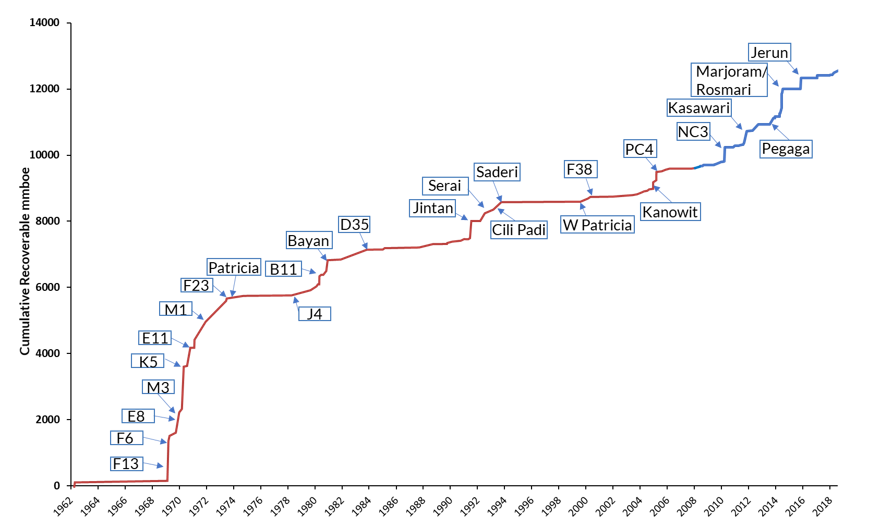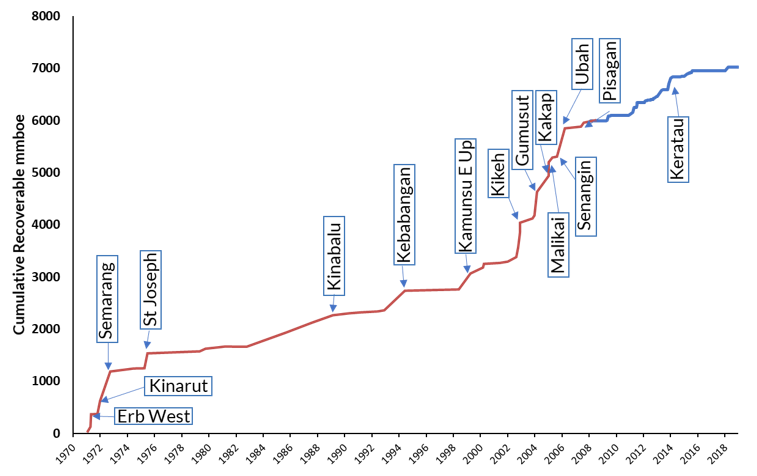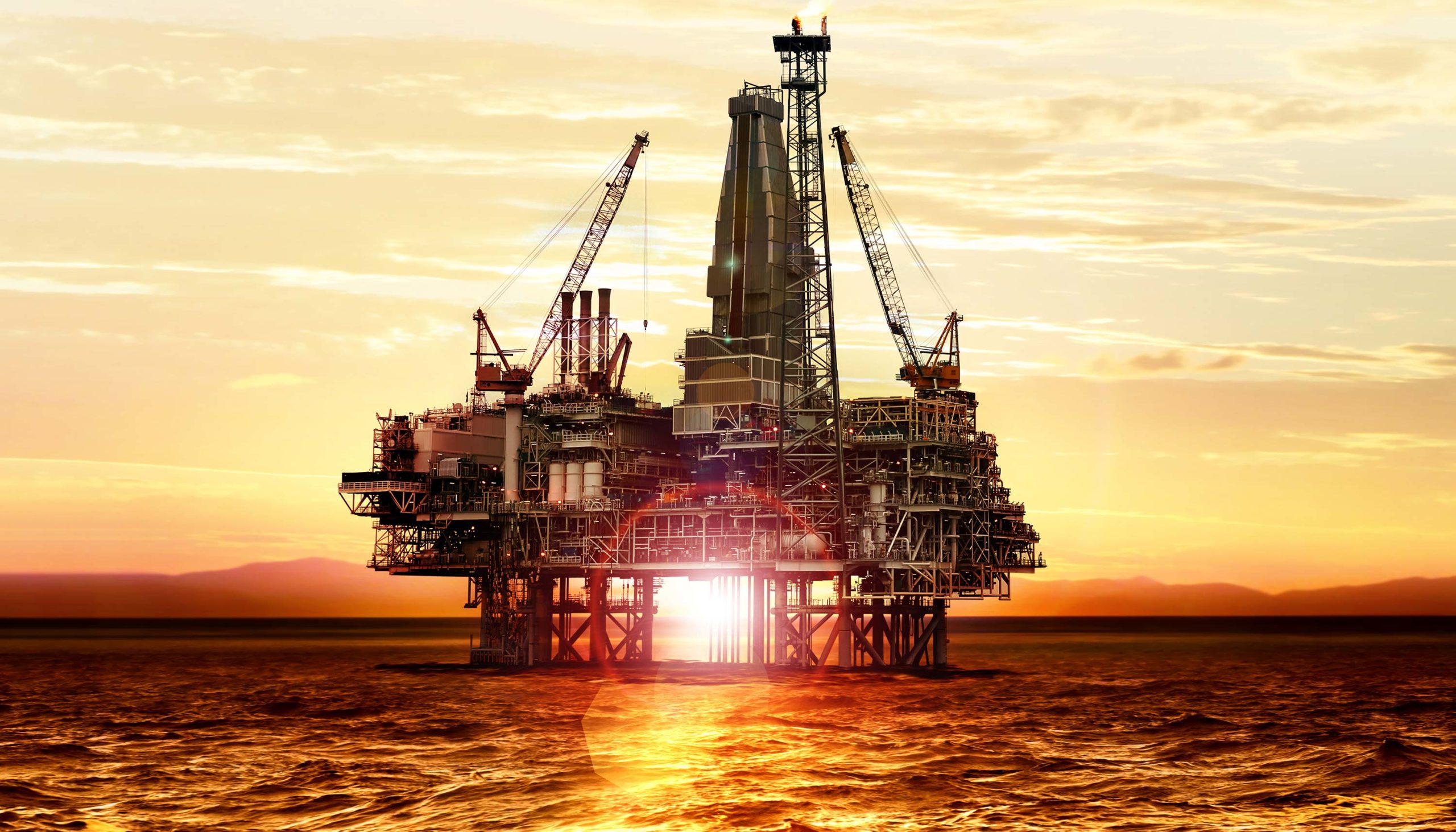Since the start of 2008, 153 exploration wells have been drilled in the SE Asia exploration hot spot of NW Borneo. 3.5bnboe has been discovered in 37 commercial discoveries, 94% of which is gas. Westwood has analysed exploration performance in both the Sarawak and Sabah basins and reviewed the potential for new frontier plays that are needed to replace reserves and maintain current levels of production.

Figure 1: Map showing exploration wells drilled offshore Sabah & Sarawak Basins in NW Borneo (East Malaysia & Brunei) including Dangerous Grounds from 2008-2018. Appraisal wells are not included. The licences shown, which are for reference only and are subject to change by host authorities, are based on a Petronas presentation to APPEX in 2016.
Source: Westwood Global Energy Group
Sarawak Basin
12.6bnboe has been discovered in offshore Sarawak Basin since 1962 (Figure 1) of which 2.8bnboe has been discovered since 2008.

Figure 2: Creaming curve by year for the Sarawak basin. 1962-2007 historical data in red based on M. Madon (2013) and 2008-2018 data from Westwood in blue.
Source: Westwood Global Energy Group
The main play in the basin is Miocene carbonate build-ups of the Central Luconia province. In shallow water the play is at the maturing stage, but there is some potential for larger discoveries in deeper water as shown by the 200mmboe discovered in Marjoram and Rosmari in 2014.
From 2008 to 2014, 50 wells were drilled in the Sarawak Basin with a technical success rate (TSR) of 72% and commercial success rate (CSR) of 42%, discovering 2.3bnboe. Since 2015, 22 wells have been drilled with a TSR of 50% and CSR of 18%, discovering 0.5bnboe. The degradation of performance is due mainly to lower discovery rates in the maturing Miocene carbonate play where the CSR dropped from 63% to 42%. Petronas recently highlighted ~120 identified build-ups that remain un-drilled (Petronas, UTP 2017), however these would seem likely to be lower quality prospects.
There have been 12 deep water wells drilled (>500m WD), with 9 drilled since 2008. Marjoram is the only potentially commercial discovery to-date and is in the Miocene carbonate play in 800m WD. The remaining wells have tested an Oligo-Miocene clastic play delivering only one non-commercial gas discovery with charge and reservoir quality being key play risks. Sarawak needs a new play to sustain exploration but deepwater frontier plays have yet to deliver and explorers need new play models to test.
Sabah Basin
Just over 7 bnboe has been discovered in the Sabah Basin (Figure 3) since 1970 with only 0.7 bnboe discovered since 2008.

Figure 3: Creaming curve by year for the Sabah basin. 1970-2007 historical data in red based on M. Madon (2013) and 2008-2018 data from Westwood in blue
Source: Westwood Global Energy Group
The main play by volume in the Sabah Basin is gas in Miocene deep water turbidites in structural traps. In shallow waters, plays are very mature, and exploration has been under performing since 2008. Only 0.2bnboe has been discovered from 41 exploration wells with a CSR of just 8%. In shallow water, no discoveries have been made since the Salman-1 discovery in 2015.
In 2002 the deepwater Kikeh-1 well extended the Miocene turbidite play into deepwater and reinvigorated exploration. Since 2008, however, the play has matured with only around 0.5bnboe being discovered from 41 deepwater wells at 56% TSR and 21% CSR with an average discovery size of 56mmboe.
So, frontier success is needed to sustain exploration in both Sabah and Sarawak Basins. The 2018 Tepat-1 well, operated by Total, tested a frontier Miocene carbonate build-up play in deepwater Sabah, and is believed to have found oil and gas though commerciality is uncertain and the results are being kept very tight. Tepat demonstrates that explorers are still testing new plays in the region and that a breakthrough could yet happen. A further two frontier plays have been identified and are reviewed in detail. Will explorers be prepared to take the risks and will these frontier plays deliver?
This is an extract from a recent Wildcat Report “Sabah & Sarawak Basins: Looking deep into NW Borneo”, published in February 2019.
To arrange a demonstration of the Wildcat service or to purchase the individual report, click here or contact Rhona McFarlane, [email protected].
Ili Afifuddin, E&P Analyst, Global Exploration & Appraisal
[email protected]




